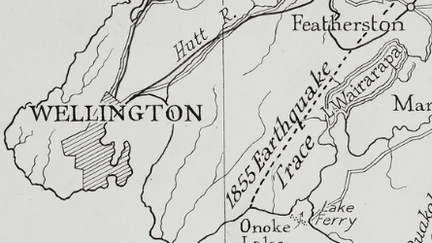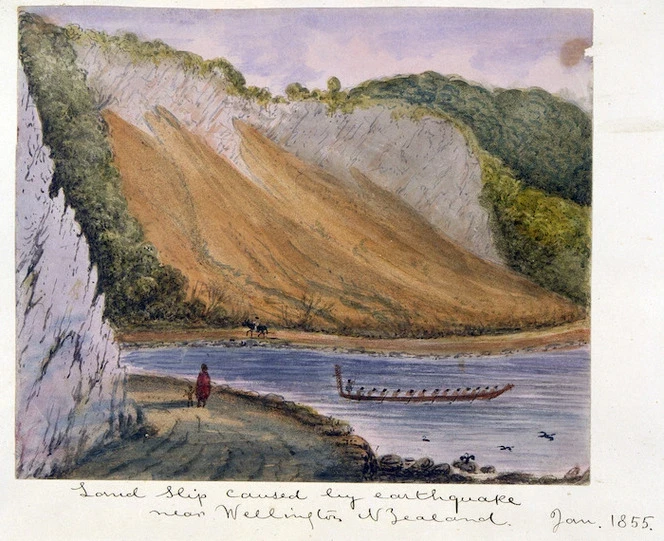Ngā Rū Whenua o Te Whanganui a Tara - Earthquakes in Wellington
In 1855, an earthquake struck the Wellington Region, permanently altering its landscape. Measuring 8.2, it was New Zealand's most powerful earthquake and was caused by movement on the Wairarapa Fault:

On Tuesday 23rd of January 1855, as the sky slowly darkened to twilight at the end of a summer's day, Wellington was preparing to go to bed.
In a small 4-roomed house in Te Aro, the Darcy family sat playing dominoes by oil lamp. At 9.15 pm, without warning, the house began to move like 'waves on a sea'.
The family were thrown to the floor and the chimney crashed through the roof, covering everything with bricks and dust. Pictures leaped from walls, tables overturned and their upright piano came down with a crash.
In the Hutt Valley, Arthur Ludlam reported that the first shock lifted his house clean off the ground and shook it from side to side before it came crashing down. On Lambton Quay, Baron von Alzdolf was killed when his house of brick, one of the very few brick structures in Wellington, collapsed in on him. Wellington had just been struck by the most devastating earthquake since human occupation began.
Though the 1855 earthquake was the most dramatic earthquake ever recorded in Wellington, many larger (and smaller) quakes have had a role in shaping our geography, our building practices, the lay-out of our city, and our social history. They have even led to the creation of urban myths - such as how until 1855, ships used to sail up what is now Kent and Cambridge Terrace, to dock at what is today the Basin Reserve. (A canal to the Basin Reserve was once planned but was never built!)
Wellington is prone to earthquakes because it rests on the point where two tectonic plates meet. Kilometres beneath Wellington the light, thick Australian plate rides over the heavier, but thinner Pacific plate. These plate movements have resulted in three major fault-lines running either through or very close to Wellington City - the Ohariu Fault, the Wairarapa Fault, and the Wellington Fault. When one of these faults shifts suddenly that earthquakes occur. The number of earthquakes which occur in Wellington has led to our city becoming one of the world's leading centres for the study and research of earthquake activity and for the development of seismic strengthening techniques in buildings.

Gold, Charles Emilius, 1809-1871. [Gold, Charles Emilius] 1809-1871 :Landslip caused by earthquake near Wellington N. Zealand Jan 1855. Ref: B-103-016. Alexander Turnbull Library, Wellington, New Zealand. /records/22330780
Historical earthquake dates
Here are some dates of larger earthquakes which were strongly felt in Wellington. Some of these resulted in considerable damage to buildings and property in the Wellington region.
Books
| Title & Author | Summary |
|---|---|
Caught in the crunch, by Rebecca Ansell (1996) |
A good general introduction to earthquakes in New Zealand with many references specific to Wellington. |
Magnitude eight plus, by R. H. Grapes (2000) |
One of the most detailed accounts of the 1855 quake. Includes personal accounts from different sources, including newspapers and illustrations which help convey the extent to which Wellington's landscape was transformed. |
The visitation : the earthquakes of 1848 and the destruction of Wellington, by R. H. Grapes (2011) |
Wellington's population was only 3,000 people in 1848. This scientific and historic account explains the cause and the quakes’ impact on early British settlers. |
A night of terror : Wairarapa's 1942 earthquake, by Jan McLaren (2002) |
This earthquake also had a big impact in Wellington. Many chimneys collapsed and Manners Street was closed to pedestrians for a few days due to the number of unsafe buildings. |
Earthquakes and uplift history of Miramar Peninsula, Wellington : report to the Earthquake & War Dam by Brad Pillans (1992) |
An unpublished academic research report written for the New Zealand Earthquake Commission. Answers - how and when did the land bridge which is now Kilbirnie, rise out of the sea to turn what was once an island into the Miramar Peninsular? |
Living on shaky ground : the science and story behind New Zealand's earthquakes, by Matthew Wright (2020) |
This book tells us how earthquakes are measured and described, and details New Zealand's well and lesser-known quakes, including the tremors that recently hit the lower North Island. |
Earthquakes, by G. A. Eiby (1989) |
First published in 1957, G.A. Eiby's classic book has undergone several expansions and revisions. Though it is not Wellington specific, it remains one of the best introductions to earthquakes in New Zealand ever written. |
More earthquakes explained, by J. J. Aitken (1995) |
This is an introductory guide to earthquakes in New Zealand with a special section dedicated to why Wellington is particularly prone to quakes. |